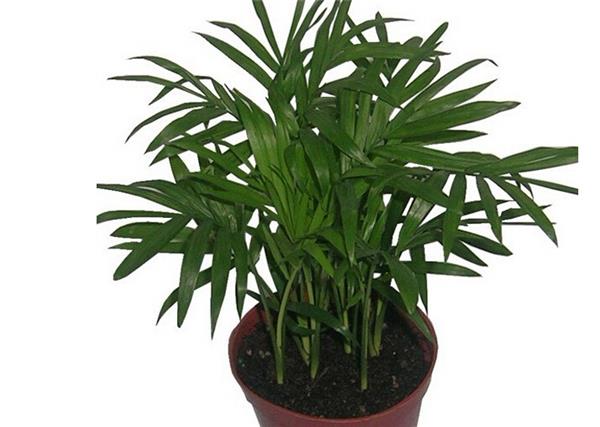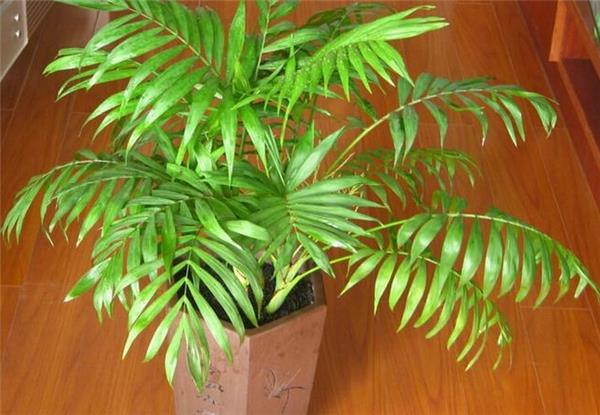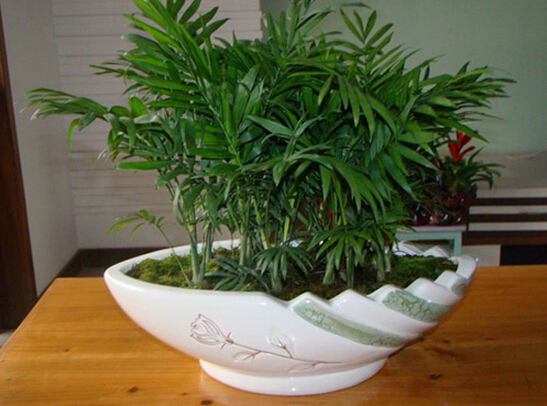What are the cultivation methods and matters needing attention of pocket coconut trees
Pocket coconut plant type is small and exquisite, beautiful and unique, generally in the home will be potted planting display in the living room, study and other places, giving a tropical scenery comfort, pocket coconut (scientific name chamaedorea elegans), also known as dwarf coconut, pocket brown, short brown. Palm family pocket coconut, also known as dwarf coconut, etc., originated in Mexico and Guatemala. Coupled with its resistance to shade, it is very suitable for indoor small and medium-sized potted plants, decorative living room, study, conference room, hotel service desk and other indoor environments, can make the indoor atmosphere and charm of tropical scenery. Put in the corner of the room or put on the tea table can add a lively atmosphere to the interior, so that the interior presents a charming tropical scenery. So, what is the cultivation method of pocket coconut trees?

The cultivation method of pocket coconut:
1, soil: pocket coconut cultivation matrix to good drainage, moist, fertile loam is the best, potted generally available rotten leaf soil peat soil plus 1/4 river sand and a small amount of base fertilizer culture for the matrix.
2. Watering: Watering should be based on the principle of wet rather than dry, and the pot soil should always be kept moist. When the air is dry in summer and autumn, water should be sprayed frequently to improve the air humidity of the environment, which is beneficial to its growth and at the same time can keep the leaves dark green and shiny; in winter, the amount of watering should be appropriately reduced to facilitate overwintering.
3, sunshine: pocket coconut likes semi-shade conditions, high temperature season avoid direct sunlight. Under the scorching sun, its leaf color will fade or yellow, and will produce scorched leaves and black spots, losing its ornamental value.
4, temperature: pocket coconut growth temperature is 20-30℃, 13℃ into dormancy, winter temperature is 10℃.
5, fertilization: fertilizer requirements are not high, the general growth season 1-2 times a month liquid fertilizer, late autumn and winter slightly fertilizer or no fertilizer.
6, pest: pocket coconut in high temperature and high humidity, easy to occur brown spot disease, available 800-1000 times Topzin or Baijunlingqing control. In dry air, poor ventilation is also prone to scale insects, except for artificial scraping, but also available 800-1000 times omethoate spraying control.
When raising pocket coconuts, the following technical problems should be noted:

① Beware of excessive light causing burnt edges. Because the pocket coconut likes a shady environment, it should be placed in the north window, near the east window or other bright scattered light; the pocket coconut is most afraid of direct light, even if it is exposed to a short period of time, it will cause the leaves to scorch and yellow. On the contrary, if it is placed in a dry and dark place for a long time, the leaf color will also fade and lose luster.
(2) Suitable temperature. Generally, the optimum temperature for growth is 20~30℃, the indoor temperature in winter is between 12~14℃, and the minimum temperature cannot be lower than 10℃.
Maintain ambient air humidity. Water should be sprayed regularly on the leaves to increase air humidity.
4 basin soil can not use acid soil, but also should add a small amount of clay.
5. The pot needs to be changed once every three years.
6 seedling stage in spring two seasons apply 3~4 times thin liquid fertilizer can be.
Pocket coconut also known as dwarf coconut. Plant shape just like tropical coconut trees, green all year round, petite and lovely. Indoor put a basin, can reproduce tropical scenery, Rao has charm. Because the root system of pocket coconut is thinner, loose fertile culture soil should be selected for potted plants, and the use of heavy clay soil is easy to cause rotten roots. Because it likes shade environment, indoor culture should be placed near the north window, east window or other bright scattered light.

Summer watering should be sufficient, and need to regularly spray water on the leaves to increase air humidity. In order to adapt to indoor viewing needs, plant height is best controlled between 40 cm and 60 cm, so fertilization should not be excessive. General seedling stage, spring, autumn two seasons apply 3-4 times thin liquid fertilizer can be. The ratio of nitrogen to phosphorus in fertilizer is 1.5: 1.2. This proportion can not only promote stem robust, but also improve leaf gloss. Change pots every 2 - 3 years in spring to facilitate growth. Because pocket coconut is not easy to survive, it is mainly propagated by seeding method. In the cultivation of pocket coconut trees when it is easy to appear yellow leaves, then what is the reason?
1, the light is too strong: the plant likes a semi-shady environment, too strong sunlight will make the leaves fade or even yellow. Treatment: Place plants in a semi-shaded area to avoid yellowing of leaves except for moderate light.
2, insufficient water: need more moisture environment, once watered too little, leaves will appear yellow or even fallen leaves. Treatment: irrigate enough water, let the soil be in a wet state during the growth period, and spray water for it in time to enhance humidity when the room temperature is too dry.
3, humidity is not enough: suitable for growth in a climate with high humidity, dry climate should take measures to increase humidity, especially in summer. Dust on the leaves is best washed off with water.
4, too much fertilizer: do not like fertilizer, too much, too thick easy to cause fertilizer damage, so that the leaves turn yellow. Treatment: only 1-2 times of thin fertilizer should be applied in one month of growth period, and less fertilizer should be applied in other periods.
5. Disease and insect infestation: Roots are prone to root rot in high temperature climate, showing symptoms of withered leaves and even death. Treatment: keep the permeability of basin soil and good ventilation of environment, and spray thiophane and chlorothalonil in case of disease.
Native to Mexico and Guatemala, the pocket coconut is an ornamental houseplant. It is named after small and exquisite, beautiful and unique. As a small and medium-sized potted plant indoors, it can add tropical atmosphere and lasting appeal indoors. So, what are the functions of the pocket coconut tree?

The role of pocket coconut
1. Appreciate the value
Beautiful plant shape, delicate, elegant, evergreen plants, leaves flat green light, umbrella-shaped plants stable simple, Jun Xiu unique, elegant leaves, full of vitality, people have a pure natural feeling, making potted plants very ornamental.
2. Decorate the room
Because of its resistance to shade, it is especially suitable for being placed in the home, whether it is on the desk, table and other countertops of the study, or hanging in a corner of the home, which can make the room full of tropical scenery atmosphere and temperament.
3. Purify the air
Pocket coconut is known as a high-efficiency air purifier, its effect is similar to Sanwei sunflower, can remove trichloroethylene, benzene, formaldehyde these harmful substances, is an assistant to purify indoor air, suitable for newly installed indoor, air conditioning.

Pocket coconut also has dwarf coconut, pocket palm, pocket sunflower, happiness palm and other alternative names, palm palm family pocket coconut genus, perennial evergreen small trees. Plant height I meters or so, warm open field cultivation can reach more than 2 meters. Root system developed. Stems slender erect, usually solitary, dark green, with ring scars of varying length at the base of leaf sheaths after leaf blade shedding. Leaves alternate, set at apex of stem, pennately divided, 30-40 cm long, lobes lanceolate, 20-40, dark green, leathery. Spike inflorescence much branch, assume panicle shape powdery. Monoecious, and same inflorescence, flowers yellow. The fruit is nearly country shaped and blue-black when ripe. Cultivations rarely bear fruit.
Showing signs of yellowing leaves, or even death. Treatment: keep the permeability of basin soil and good ventilation of environment, and spray thiophane and chlorothalonil in case of disease.
Native to Mexico and Guatemala, the pocket coconut is an ornamental houseplant. It is named after small and exquisite, beautiful and unique. As a small and medium-sized potted plant indoors, it can add tropical atmosphere and lasting appeal indoors. So, what are the functions of the pocket coconut tree?

The role of pocket coconut
1. Appreciate the value
Beautiful plant shape, delicate, elegant, evergreen plants, leaves flat green light, umbrella-shaped plants stable simple, Jun Xiu unique, elegant leaves, full of vitality, people have a pure natural feeling, making potted plants very ornamental.
2. Decorate the room
Because of its resistance to shade, it is especially suitable for being placed in the home, whether it is on the desk, table and other countertops of the study, or hanging in a corner of the home, which can make the room full of tropical scenery atmosphere and temperament.
3. Purify the air
Pocket coconut is known as a high-efficiency air purifier, its effect is similar to Sanwei sunflower, can remove trichloroethylene, benzene, formaldehyde these harmful substances, is an assistant to purify indoor air, suitable for newly installed indoor, air conditioning.

Pocket coconut also has dwarf coconut, pocket palm, pocket sunflower, happiness palm and other alternative names, palm palm family pocket coconut genus, perennial evergreen small trees. Plant height I meters or so, warm open field cultivation can reach more than 2 meters. Root system developed. Stems slender erect, usually solitary, dark green, with ring scars of varying length at the base of leaf sheaths after leaf blade shedding. Leaves alternate, set at apex of stem, pennately divided, 30-40 cm long, lobes lanceolate, 20-40, dark green, leathery. Spike inflorescence much branch, assume panicle shape powdery. Monoecious, and same inflorescence, flowers yellow. The fruit is nearly country shaped and blue-black when ripe. Cultivations rarely bear fruit.
- Prev

What are the nutritional values and therapeutic values of Flammulina velutipes?
What are the nutritional values and therapeutic values of Flammulina velutipes?
- Next

A few simple steps to learn how to raise copper grass and what role it has
A few simple steps to learn how to raise copper grass and what role it has
Related
- Wuhan Hospital Iron Tree Blooming Result Was Instantly Frightened by the Gardener Master
- Which variety of camellia is the most fragrant and best? Which one do you like best?
- What is the small blue coat, the breeding methods and matters needing attention of the succulent plant
- Dormancy time and maintenance management of succulent plants during dormancy
- Minas succulent how to raise, Minas succulent plant pictures
- What are the varieties of winter succulent plants
- How to raise succulent plants in twelve rolls? let's take a look at some experience of breeding twelve rolls.
- Attention should be paid to water control for succulent plants during dormant period (winter and summer)
- Watering experience of twelve rolls of succulent plants
- Techniques for fertilizing succulent plants. An article will let you know how to fertilize succulent plants.

